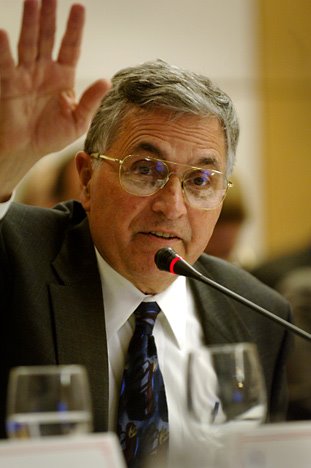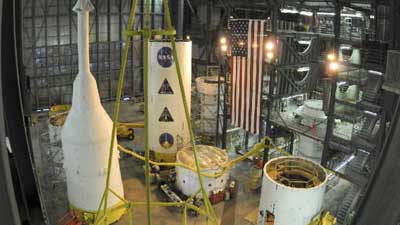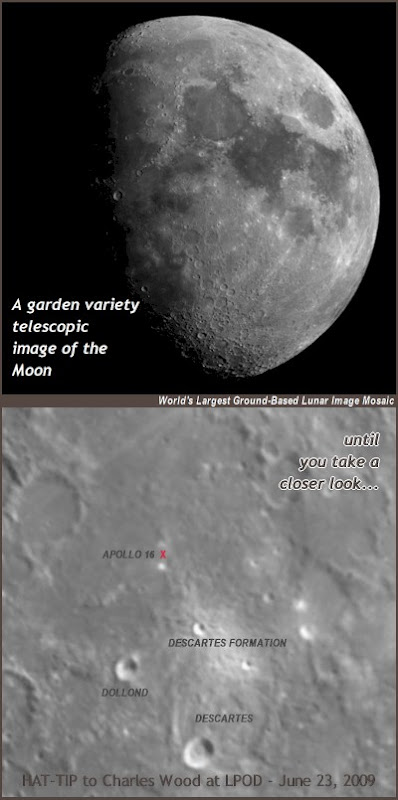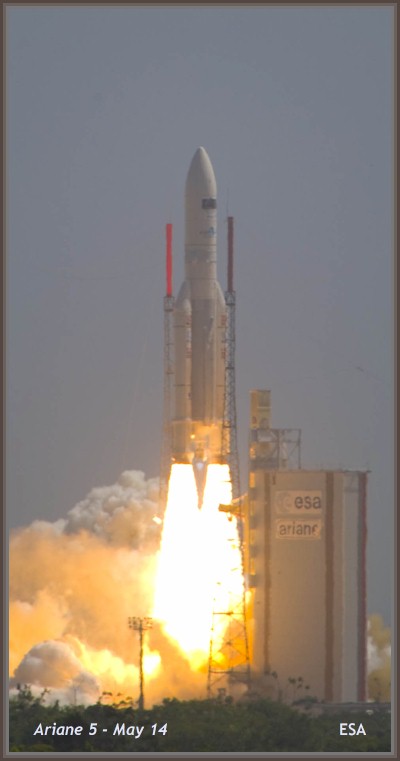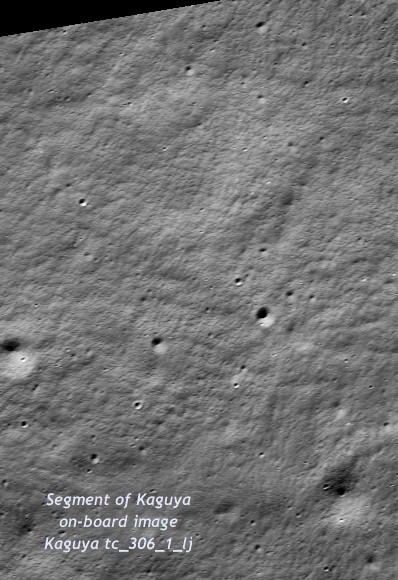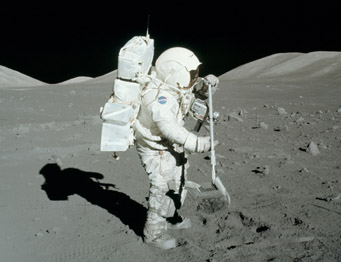Monday, June 29, 2009
Concordia: "If I can make it there..."
 Based on the first compartment in ESA's MELISSA project, a black water recycling system is under construction for Concordia research base in Antarctica. The Concordia Station is a scientific base built in Antarctica by the French Polar Institute (IPEV) and the Italian Antarctic Programme (PNRA). Credit: IPEV
Based on the first compartment in ESA's MELISSA project, a black water recycling system is under construction for Concordia research base in Antarctica. The Concordia Station is a scientific base built in Antarctica by the French Polar Institute (IPEV) and the Italian Antarctic Programme (PNRA). Credit: IPEV"Winter in Antarctica is harsh. Temperatures occasionally going as low as -84ºC, permanent darkness and isolation are only some of the conditions that crews at the Antarctic station Concordia have to brave. These challenging circumstances could help prepare for future human space exploration missions."
As the Summer Solstice peaked daylight length in the Northern Hemisphere, June 21, my thoughts turned to the deepest south, Antarctica, the subject of intense study continually since the International Geophysical Year fifty years ago. At one time, no human or animal life could be found there. The mean average population is now 5,000, military, science and ancillary personnel who have given us a large body of data on human adaptation made possible by high technology.
Even at 35 degrees north of the equator, the night passes quickly, from twilight's end to its beginning, barely 8 hours, and a never-setting Sun north of the Arctic Circle. In contrast, at Byrd Station, the Sun dipped below the horizon to stay weeks ago, and the twilight will precede dawn for half a month before it is seen again. To say life in Antarctica is one of extremes is an understatement. Mitigation of the disorienting effects on circadian rhythm have provided vital clues on how humans will eventually live with two week days and nights, or a Sun almost never sets at all, if Armstrong Station is ever built.
In short, life in Antarctica has become our first opportunity to understand what life will be like on the Moon, and on Mars. It's an easy bet if life were impossible to maintain on the continent of Antarctica, with no aboriginal human experience as guide, life on the Moon would be unthinkable. The same can be said of life in low Earth orbit, which on the launch of STS-127 Endeavour, hopefully on July 11, can safely be said for only 500 persons since 1961.
It may well be recorded one day that without our gathered experiences of living in Antarctica and for months in low Earth orbit, survival on the Moon would have been impossible. Looking even further down the road, we are likely to admit without similar experience adapting to life on the Moon, our trips beyond it would have been folly.
With these things in mind, ESA has just posted a brief feature on life and the French and Italian Concordia Station in Antarctica on the part of that agency's website devoted to Human Spaceflight and Exploration.
Igniting Fusion
 Ground zero: A circular access port affords a glimpse into a 10-meter-diameter target chamber where, in the coming months, powerful lasers will be fired with the goal of setting off small thermonuclear explosions.
Ground zero: A circular access port affords a glimpse into a 10-meter-diameter target chamber where, in the coming months, powerful lasers will be fired with the goal of setting off small thermonuclear explosions.(See more images.) Credit: Jason Madara
Kevin Bullis
MIT Technology Review
July-August 2009
It's late April and workers are assembling the last parts of the National Ignition Facility (NIF), a sprawling building covering the area of three football fields at Lawrence Livermore National Laboratory in Livermore, CA. Dressed in hard hats, hair nets, lab coats, and latex gloves, they have gathered at the target chamber, a sphere 10 meters in diameter and bristling with 48 burnished-aluminum ducts that together house 192 separate laser beams. Each beam on its own is one of the world's most powerful, says Bruno Van Wonterghem, operations manager at NIF. Together they deliver 50 to 60 times the energy of any other laser.
Jack Schmitt disputes Michio Kaku
Dr. Harrison H. "Jack" Schmitt, lunar module pilot for the Apollo 17 mission, was an exacting scientist before and long after after he took any geologist's "dream field expedition." In December 1972, with Gene Cernan he explored the Taurus-Littrow valley and came back with stunning samples from a crossroads of lunar morphology.
He stayed on with NASA after what would be the last visit to the lunar surface, at the Apollo sample receiving lab, and continued to derive results and publish, usually posing many more new questions raised from the sample studies rather than rush to conclusions much beyond what the evidence suggested. Instead, he constrained the range of possibilities.
In a field with many excellent planetary scientists, including many with equally distinguished records that show as deep an awareness of our improving, but far from complete, understanding of Earth's Moon, Jack Schmitt could claim preeminence, but does not. In his writings, he constantly shows a respect for conclusions raised by colleagues, and when he disagrees, he's nearly always gentle, recognizing the limitations of people and empiricism, channeled continually toward progress rather than perfection.
It is a time when greater government funding than ever before, together with the old dictum requiring scientists to "publish or perish," and public relations sometimes seems to have triumphed over the necessarily slow progress yielded by the Scientific Method. Lacking much credibility of their own, politicians cling to science to stay afloat. Few would scientists would understand that better than former U. S. Senator Harrison Schmitt, as well. This hasn't stopped him from continuing to insist that "consensus," however it may be understood in political circles, is the best or the only way science gets closer to the truth.
"'Consensus,' as many have said, merely represents the absence of definitive science."
On June 23 Michio Maku, the popularizer of cosmology, wrote a column in the Wall Street Journal called, "The New Race to the Moon."
In a letter on June 29 to the Journal Schmitt responded, writing, "Michio Kaku provides a clear summary of the apparent international interest in following Americans to the Moon ("The New Race for the Moon," op-ed, June 23). However, he seems strangely uninformed about the moon's strategic and economic values. Strategically, simply imagine the future of the U.S. and liberty if a totalitarian society becomes the dominant space-faring nation of the Earth. To that society would accrue all the technical, political and prestige value that once came to us as a result of the Apollo 11 landing on the moon 40 years ago this July 20."
"Economically, the moon does have "air and water," contrary to Mr. Kaku's assertion. Heating the lunar soil will release abundant hydrogen, helium, carbon and nitrogen (all implanted by the solar wind). In that heating process, hydrogen also reacts with lunar minerals to produce water from which oxygen can be derived. All of these resources obviously have economic value for other activities on the moon and in space."
The complete text of Dr. Schmitt's letter to the Wall Street Journal, "To Infinity and Beyond, or at least Back to the Moon," can be read HERE.
Spaceport Indiana?
Ares I-X concerns could scrub test
Robert Block
Orlando Sentinel Space Editor
The violent shaking that threatens to destroy the Ares I rocket that NASA hopes will one day return astronauts to the moon is also threatening to delay — or even cancel — the first flight of its test version, the Ares I-X.
Air Force officials who have safety jurisdiction over all launches from Kennedy Space Center are worried that the rocket's vibrations could knock out the self-destruct mechanism required in case the launch goes awry.
If the Ares I-X went out of control during its scheduled launch Aug. 30, and the destruct mechanism failed, the rocket could threaten populated areas along the Space Coast.
Update on LCROSS Impact
On October 9 the Moon and LCROSS will try to occupy the same spot at the same time, and LCROSS, as expected, will be obliterated by the encounter. If all goes as planned its impact will take place within one of many craters around the Moon's South Pole with interiors permanently in shadow and perhaps sheltering ancient stores of ice , in one form or another.
The impact may even occur within the same crater Shoemaker Lunar Prospector was guided into at the end of its historic mission in 1999.
If LCROSS impact takes place there, or perhaps inside its neighbor Faustini, then a famous gap through the ancient Near Side rim of South Pole Aitken Basin, a gap between the Malapert and "Leibnitz Beta" known as "the Keyhole" might afford a barely favorable view from as far east as Texas.
Final targer selection is not expected before the latter part of September, NASA Ames says, however, that the LCROSS impact is expected to happen within 30 minutes of 1130 UT (7:30 am) on October 9.
U.K. reviews future In Space
Science minister Lord Drayson said that space work plays a huge part on daily lives. The new panel, the Space Innovation Growth Team (Space IGT), is headed by Andy Green, the chief executive officer of Logica.
His IT company offers software to space companies and is in a successful position to review the industry, from hardware manufacturing to applications. The IGT will listen to the entire sector, to hear from companies that entirely depend on space technology.
The goal of Green's panel is to outline a 20-year strategy for the British space industry. It will try to locate the key trends and then catalog the steps that both the industry and government have to take if they want to embrace any changes.
Space Camp for Teachers
 Heather McCarron
Heather McCarronMilford Daily News
If Jim Schliefke ever had the chance to go to space, he'd jump at the chance. "Definitely," he said this week, affirming the declaration with a nod.
It was a courageous statement coming from someone who, just the week before, had crash-landed the space shuttle in water.
But then, it was only his first landing, clarified the nine-year Horace Mann Middle School science teacher as he sat in his classroom recalling the incident - and nobody was hurt.
It was all part of a simulation, with Schliefke cast as space shuttle pilot, at the Space Academy for Educators, a program offered at Space Camp.
The Franklin resident was among 16 educators from around the globe who spent a week in astronaut-style training, and discovering new ways to inspire their students.
Schliefke attended the program on a scholarship from Honeywell - one of 288 teachers from 16 countries and 47 states selected from among 1,200 applicants to take part in the Honeywell Educators @ Space Academy programs at the U.S. Space & Rocket Center in Huntsville, Ala. over the course of the summer.
Sunday, June 28, 2009
Pittsburgh astronaut looks beyond moon
Pittsburg Tribune - TribLIVE/Opinion
Dr. Jay Apt's astronaut days came long after the Apollo missions to the moon, centering instead on NASA's space shuttle program.
But he was present at Kennedy Space Center in Florida at 9:32 a.m. on July 16, 1969, when Apollo 11 lifted off on its way to mankind's first lunar landing -- and his ideas about what the space agency, and private space ventures, should be aiming for these days differ markedly from NASA's.
As July 20's 40th anniversary of Neil Armstrong's historic first steps on the moon approaches, renewed and growing public and media buzz focuses on Apollo 11.
But Apt says he first drew inspiration for the direction his career would take from NASA's earlier Mercury program, which first put an American in space, and Gemini program, which flew two-man spacecraft that worked out docking and rendezvous procedures that would be critical for Apollo missions.
As the launch of Apollo 11 approached, Apt was a Harvard undergraduate -- and, fortuitously, one of the folks helping run Model Rocketry, a 50,000-circulation monthly magazine. That work enabled him to snag a press pass that he used to witness the launch from Pad 39-A in person, an experience that made a lasting impression.
"It was just wonderful," Apt recalls. "It certainly was inspirational."
He would not join NASA until 1980, when he became a planetary scientist at its Jet Propulsion Laboratory in Pasadena, Calif. In 1982, he began a three-year stint at the Johnson Space Center in Houston, where he was a flight controller responsible for shuttle payload operations.
Apt was selected as an astronaut candidate in June 1985 and qualified as an astronaut in July 1986, but he was not bothered that no lunar mission ever would be possible for him.
Read the posting HERE.
Saturday, June 27, 2009
Bob Crippen weighs in on 'Gap'
before NASA's next big project
Houston Chronicle
On July 20, people around the world will celebrate an American triumph. The 40th anniversary of the Apollo 11 moon landing recalls a period of ingenuity and perseverance that captured the world’s imagination. I was in Houston interviewing with NASA for a spot in the astronaut corps during that phenomenal yet bittersweet moment. Even as humans touched the lunar surface for the first time, we knew we wouldn’t be doing it much longer. The program was winding down because of budget constraints.
The Apollo 11 anniversary this year and the scheduled end of the shuttle program next year evoke many of the same conflicting emotions we felt behind the scenes in 1969. When Apollo missions ended in 1972, thousands of our brightest and most committed became unemployed.
The current plan calls for a several-years-long gap between the end of the shuttle program and the first flight of the Constellation program, NASA’s initiative to return to the moon and beyond. That gap could mean another brain drain as talented, skilled contractors and NASA employees must take their institutional knowledge elsewhere.
We were in that situation when we started the shuttle program — training a new, inexperienced workforce. As one of the few people in the world who has piloted a never-before-flown spacecraft, I’m here to tell you — you want experienced engineers and technicians on your team.
I also witnessed firsthand the economic devastation of the aerospace industry downturn while working at Kennedy Space Center in Florida in the 1970s. The six-year gap between the Apollo and shuttle programs cost America more than 400,000 jobs. The Space Coast, Houston and other cities that thrived on aerospace were hit especially hard. Once again, we face the prospect of thousands of layoffs and the residual economic blow nationwide.
Based on the long-term view of President Obama’s support for America’s space exploration program, my fervent hope is that he will both minimize the gap and build on JFK’s vision, returning America to its greatness as a space-faring nation.
Buzz Aldrin's candor has saved many lives
He and Dr. Neil Armstrong share the distinction, of course, of being first to land on the Moon but Buzz Aldrin still thinks the tradition of a junior officer going ashore ahead of a mission commander ought to have been followed on that precedence-setting mission. He clearly holds no grudge, however. He's just remarkably honest about his feelings of the protocol he still believes ought to have been followed on that first trip to the lunar surface.
And this lack of resentment may be a key to understanding much about Colonel Aldrin. His attitude clearly follows the traditions of Alcoholics Anonymous, those that were recommended by that organization's co-founder Bill Wilson, "neither to dwell upon the past nor shut the door entirely" on an A.A. member's personal experiences" as integral to a lifestyle of recovery, one requiring "rigorous honesty."
There are still some members of A.A., however, ones hold fast to A.A.'s Twelve Traditions and who will argue to this very day about Buzz Aldrin's appearance at a "controversial" press conference that featured celebrities who tested the envelope of those tradition by going public about their recovery. There are some A.A. members who insist this violated their Program's tradition of Anonymity.
It's a fine line, perhaps as fine an edge as repeated "601" alarms sounding clarion calls from a remedial flight computer, overloaded with information as Neil Armstrong and Buzz Aldrin and the computer monitored the parameters of the first landing of a lunar module anywhere, let alone the Sea of Tranquility.
Anonymity is the name of the game, the name taken from the Big Book after which the Program, itself, was named, in 1935. Those who don't take the precepts seriously, as a matter of life or death, don't belong in the Program. Anonymity is encouraged, in the canon of A.A. to protect the reputation of the Program. The same protection it affords to its Membership is an added benefit only.
Aldrin, actor and comedian Dick Van Dyke, and many others attended this well-publicized press appearance highly aware of this interpretation of an important A.A. tradition. Each of those who came forth were respected individuals who led very public lives. They were careful not to mentioned A.A. when they went public about their alcoholism. Still, there was little question that it was within A.A. where each of those present had found each other and found a working method to follow for recovery.
Since July 1969, Neil Armstrong's well-known reticence clearly contrasted with Colonel Aldrin's openness, a willingness to talk with just about anyone at any time about nearly anything, and this continues to this very day as the Colonel makes almost daily public appearances and travels during these days heading up to the 40th anniversary of that first landing on the Moon on July 20.
Colonel Aldrin looks remarkably fit for a man 79 years old. He has a new autobiography in print, with a title taken from his own first words he spoke after following Neil Armstrong out onto the lunar surface.
"Magnificent Desolation."
Aldrin's personal ordeal upon his return to Earth, clinical depression and alcoholism became the central them of his autobiography, appropriately entitled "Return to Earth," an inspirational best seller published in 1973.
As controversial as his public affirmation about his difficulties was, for only a brief time within the far flung meetings of millions of members of A.A. ultimately did nothing to threaten the reputation of A.A., primarily because both he and Dick Van Dyke stayed sober and both still "share experience, strength and hope" with countless others searching for survival as they suffer from what was once considered completely hopeless.
The fact there is today such little stigma associated with the admission and, more importantly, the acceptance of alcoholism is something else our civilization owes to Colonel Aldrin, as much as the similar earlier public declarations made by former First Lady Betty Ford, Van Dyke and many others who challenged public perceptions of what a person who attends A.A. meeting looks like.
A great many people owe Colonel Aldrin their lives. Even if I am not in accord with his vision of putting Mars ahead of unfinished business on Earth's Moon, I will never forget the fact that I owe him my life just as surely as if he had saved me from drowning.
Friday, June 26, 2009
Hutchison inserts funds for A&M Advanced Robotics for Lunar and Martian Exploration
An initial drafts of Senate changes to the House plan restore overall funding totals requested by President Obama, though mark-up in the Senate allows Senate members to include amendments that channel funds to special projects in the home state. Senator Kay Bailey Hutchison (R-TX), who has announced plans to retire to challenge Texas Gov. Rick Perry in 2010 announced on Thursday the Senate Appropriations Committee had accepted an amendment offering $750,000 ti Texas A&M University's Advanced Robotics for Lunar and Martian Exploration.
According to a press release from Senator Hutchison's office, she said, “At this critical juncture in human space flight and exploration at NASA, Texas A&M University will be at the forefront of robotic research and Lunar and Martian investigation.
"The Advanced Robotics for Lunar and Martian Exploration project, led by Dr. John Junkins, a member of the National Academy of Engineering and the Texas Academy of Medicine, Engineering, and Science, will develop new robotic technologies that enable multiple robots to collaborate, under high-level human supervision in exploration and construction activities for NASA exploration plans. The initiative will also develop advanced sensing and computing architectures to enable robotic landings on rough terrain"
Background on LRO DIVINER
In addition to creating a comprehensive atlas of the moon’s features with detailed information about surface and subsurface temperatures, Diviner will identify cold traps and potential ice deposits, as well as landing hazards such as rough terrain or rocks to be avoided by future manned missions to the moon.
JPL designed, built and manages the Diviner instrument for NASA’s Exploration Science Mission Directorate, Washington. UCLA is home institution of Diviner’s principal investigator, David Paige. NASA's Goddard Spaceflight Center, Greenbelt, Md., manages the Lunar Reconnaissance Orbiter. It is a NASA mission with international participation from the Institute for Space Research in Moscow.
http://diviner.ucla.edu/
Public tour of lunar sample lab, July 7
Live interview opportunities will be available from 6 a.m. to 8 a.m. and 2 p.m. to 4 p.m. CDT with lunar sample scientists Gary Lofgren and Andrea Mosie. Lofgren is the lunar curator at Johnson and has been with the lab since the Apollo era. Mosie has been a scientist in the current lab since it opened in 1979.
The public also will have an opportunity to take a virtual tour of the lunar sample lab and ask the scientists questions via Ustream and Twitter from 12 p.m. to 1 p.m. The public can submit questions to Johnson's Twitter account, @NASA_Johnson, beginning today and via Ustream live during the event. The tour and the question-and-answer session also will be broadcast live on NASA TV.
To view the live broadcast on Ustream and submit questions, visit:
http://www.ustream.tv/channel/nasa-live
Triple eclipse a virtual phenomena
This partial eclipse, such as it is, begins at 8:37:51 UT, as the Moon's farthest northern hemisphere rolls through the southern most outer hazy edge of Earth's shadow. The naked eye west of the Mississippi River will not detect any event whatsoever. But it lasts one hour and forty six minutes and ends at 10:39:23. There's the skinny on that "event," hardly qualifying as an "eclipse" at all.
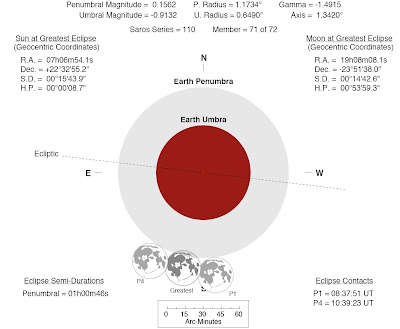
Unfortunately for me, and others living in the Western Hemisphere, this magnificent and majory Total Eclipse of the Sun occurs on July 22.
The path of the Moon's Umbral shadow extends across India, China, a sprinkling of Japan and the South Pacific and a partial eclipse will be seen "within the much broader path of the Moon's penumbral shadow, which includes most of eastern Asia, Indonesia, and the Pacific Ocean," NASA reports.
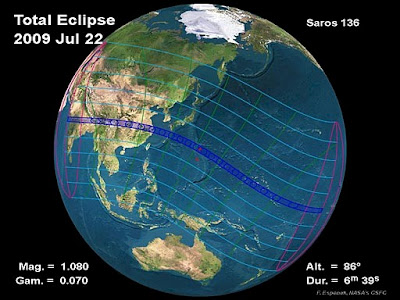
"Triple eclipse, to be witnessed in July and August this year, is a rare astronomical event and Indian authors express fears of it being a bad omen. Lunar Eclipse on July 7 followed by solar eclipse on July 22 and lunar eclipse on August 6 motivated a southern Bangalore based couple D. K. and Hema Hari to search for answers about the significance of this historical event in the present times."
Oh, well, the "couple underwent empirical study about the rare event and have recently released their book," entitled, "Will history repeat itself? Triple eclipse of July 2009."
If anything, the most dramatic eclipse in this "triple play" can be witnessed by more than two billion inhabitants of Earth, a month from now. Photography of Total Eclipses has continued to improve, however, with no ceiling in view.
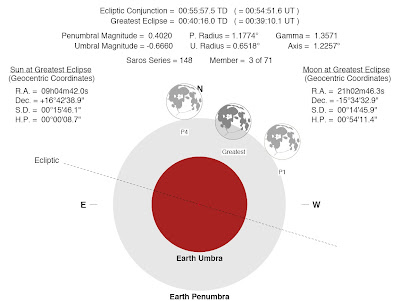
Thursday, June 25, 2009
Wednesday, June 24, 2009
NASA criticised for sticking to Imperial units
NASA's decision to engineer its replacement for the space shuttle using imperial measurement units rather than metric could derail efforts to develop a globalised civilian space industry, says a leading light in the nascent commercial spaceflight sector.
"We in the private sector are doing everything possible to create a global market with as much commonality and interoperability as possible," says Mike Gold of the US firm Bigelow Aerospace, which hopes to fly commercial space stations in orbit. "But NASA still can't make the jump to metric."
Gold chairs a Federal Aviation Administration working group on commercial spaceflight that is trying to change strict State Department rules affecting civilian spaceflight systems. He sees NASA's decision to use imperial units as the latest blow to hit the sector.
Read the Article HERE.
World Record Moon Mosaic 2009
Descartes A, is about 10 kilometers across.
Part-Time Scientists go for GLXP
 Shooting for the Stars, Settling for the Moon, their motto, the "Part-Time Scientists" Team is officially contending for the Google Lunar X-Prize.
Shooting for the Stars, Settling for the Moon, their motto, the "Part-Time Scientists" Team is officially contending for the Google Lunar X-Prize.With their official entry into the Google Lunar X PRIZE competition, Part Time Scientists marks another German team the new race to the Moon, the $30 million contest "that challenges space professionals and engineers from across the globe to build and launch a privately funded spacecraft to the Moon."
The GLXP winner must complete a series of tasks outlined in the GLXP rules.
Team Part-Time-Scientists is headquartered in Berlin, and has seven team members, now among 19 teams from 42 countries competing for the GLXP purse.
"The Part-Time-Scientists are not only the first German team to join the competition but also one of the youngest as the vast majority of team members are in the 20’s. In addition, this is the first team made up entirely of non-space professionals. The seven members are scattered across northern Germany and welcome everyone who wants to join their efforts."
Team leader Robert Boehme: "We want to prove to the world that the labor of a few dedicated, hard working people is equivalent with that of a 100 rocket scientists. We believe the future of humans is among the stars. For that to happen, we have to get humans out of low earth orbit again. One doesn't have to be in a space agency to fly into space. Thanks to the X PRIZE Foundation, private companies have built vehicles that can travel beyond the edge of our atmosphere. Going to the Moon, even if it's just a man made robot, is the next logical step for private space exploration.”
Snoop Dogg & Master Buzz
Gestures add-up: Bonham 4-H Flag flies on STS-127
What Buzz Aldrin was doing in Hong Kong
 The Hong Kong Space Museum saw a massive surge in traffic this weekend as over 10,000 people visited the "Beyond Time" exhibition by the Museum and OMEGA during a three-day run that ended
The Hong Kong Space Museum saw a massive surge in traffic this weekend as over 10,000 people visited the "Beyond Time" exhibition by the Museum and OMEGA during a three-day run that ended In the accompanying photograph, Aldrin proudly shows off a watch on both wrists, though some commented it was a new pose in practice for the former astronaut's new joint project with Rapper Snoop Doggy Dogg.
Highlighting the event, Dr. Aldrin and NASA Aerospace Engineer
Miss Jenny
Two secondary school students representing the 1990s,
Following the launch event, the exhibition was immediately opened to the public, resulting in a steady flow of museum-goers and photographers for the remainder of the weekend.
Sealaunch goes belly up?
 June 23 (Reuters) - Satellite-launch services provider Sea Launch Co along with 5 affiliates filed for Chapter 11 protection, Tuesday. In U.S. Bankruptcy Court for the District of Delaware, Sea Launch listed assets of up to $500 million and liabilities of more than $1 billion. In Sea Launch Co LLC et al, U.S. Bankruptcy Court, District of Delaware. No. 09-12153 representatives cited liquidity "concerns" and operational losses.
June 23 (Reuters) - Satellite-launch services provider Sea Launch Co along with 5 affiliates filed for Chapter 11 protection, Tuesday. In U.S. Bankruptcy Court for the District of Delaware, Sea Launch listed assets of up to $500 million and liabilities of more than $1 billion. In Sea Launch Co LLC et al, U.S. Bankruptcy Court, District of Delaware. No. 09-12153 representatives cited liquidity "concerns" and operational losses.The Long Beach, California-based company said in the filing it intends to explore the sale of one or more of its divisions, according to Reuters.
Sea Launch, which offerred equatorial launch services on ocean-going platforms and commercial launch services from Baikonur is owned by Boeing, Energia and Norway's Aker ASA, among others.
Visual sequence from LCROSS
Some complained of the over-exposed Far Side, though the visible light camera, at one frame per second, was tuned to bring out the dimmer and shadowed relief of the sunrise terminator. The eye acquainted the Moon's feature could easily pick out the Sea of Moscow, however, and washed out in this image, Mendeleev, a second among the fifty highest priority future human landing sites, was visible in others in the range of LCROSS instruments.
Like LCROSS, the Moon had continuing to move on its ancient orbit, to the "left" in this view, more of the southern hemisphere, Mare Marginis and the lava filled crater Goddard. The encounter came at New Moon. The Moon and LRO part company with LCROSS, whose next encounter October 9 will be arrived at from below.
Tuesday, June 23, 2009
LRO makes orbit, LCROSS moves on
 Engineering and calibration, not science, were highest priorities for controllers of the LCROSS mission at Ames, Tuesday. Nevertheless, an hour was made available to do a little of both, long after the Centaur impactor and its shepherding payload had slipped far north and away from the Moon, already having continued itself away from their brief rendezvous, toward the "left" in this view.
Engineering and calibration, not science, were highest priorities for controllers of the LCROSS mission at Ames, Tuesday. Nevertheless, an hour was made available to do a little of both, long after the Centaur impactor and its shepherding payload had slipped far north and away from the Moon, already having continued itself away from their brief rendezvous, toward the "left" in this view.Among the science targets of opportunity for remote sensing was Mendeleev, invisible in the glare of mid-day on the Far Side. The visible imaging camera was tuned to the rich relief of the dimmer terminator in this first "live" television view from the Moon since 1972.
 |
| From Lunar Pioneer 3 |
The New Race for the Moon
By Michio Kaku
Wall Street Journal
Last Thursday, the National Aeronautics and Space Administration (NASA) sent two probes to the moon in search of a possible site for a manned lunar station. Both China and the U.S. have announced that they plan to send manned missions to the moon around 2020. India and Japan are not far behind, launching their own unmanned probes to the moon and laying out their timetables for sending men there.
Will we see a pileup on the moon around 2020?
LCROSS swingby calibration live
LRO will begin it's long tour of the Moon at 0943 UT (5:43 am EDT, at Goddard Space Flight Center in Maryland).
LCROSS will begin an hour-long test beginning at approximately 1220 UT (5:20 am PDT at NASA Ames in California). This is scheduled to begin and hour and fifty minutes after the spacecraft reaches perilune at 10:30 UT (3:30 am PDT).
"The first 30 minutes will contain a view of the lunar surface from an altitude of approximately 9,000 km. The video feed is set to display one frame per second. During the latter 30 minutes, the spacecraft will perform multiple scans of the moon's horizon to calibrate its sensors. During this latter half hour, the video image will update only occasionally."
Graphic visualization of LCROSS and it's dance with the Moon can be followed HERE.
Monday, June 22, 2009
Definitive story of Augustine Committee meeting, last week
The reason is simple. We knew Jeff Foust of Space Politics and the Space Review was in attendance.
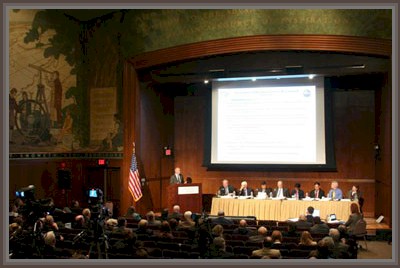
The Review of US Human Space Flight Plans Committee
held their first public meeting in Washington last week.
- The Space Review
"The committee’s first meeting, held last Wednesday at the Carnegie Institute for Science in Washington, DC, appeared to confirm those beliefs. Much of the eight-hour hearing was devoted to examining Constellation and well as several alternative systems that could be ready sooner and/or with less money than the incumbent. And while the committee dropped no hints about what direction it might be leaning, the hearing certainly triggered discussion within and outside the meeting that will last all summer, if not beyond."
Meeting Agendas
- June 17 Public Agenda (pdf, 11k)
Meeting Presentations
- 9:20am - Summary of past studies - NASA/Mike Hawes (pdf, 60k)
- 9:30am - Constellation Program - Nasa/Doug Cooke (pdf, 4.55MB)
- 10:00am - ISS Partner Discussion - ESA - Jean-Jacques Dordain (pdf, 241k)
- 10:00am - ISS Partner Discussion - RSA - Perminov (pdf, 460k)
- 12:00pm - Comments via Website (pdf, 81k)
- 1:00pm - EELV Considerations - NASA Expendable Launch Services Current Use of EELV - Lynn Cline (pdf, 590k)
- 1:00pm - EELV Considerations - Briefing to the Review of U.S. Human Space Flight Plans Committee - Michael Gass (pdf, 3.03MB)
- 1:00pm - EELV Considerations - Initial Summary of Human Rated Delta IV Heavy Study - Gary Pulliam (pdf, 123k)
- 2:00pm - Other Commercial Launch Capabilities - NASA COTS - NASA/Doug Cooke (pdf, 773k)
- 2:00pm - Other Commercial Launch Capabilities - SpaceX COTS - SpaceX (pdf, 3.67MB)
- 2:00pm - Other Commercial Launch Capabilities - Orbital COTS - Orbital (pdf, 3.34MB)
- 2:00pm - Other Commercial Launch Capabilities - ISS CRS - NASA/Mike Suffredini (pdf, 790k)
- 3:30pm - Alternative Architectures - Direct - Steve Metschan (pdf, 26.9MB)
- 3:30pm - Alternative Architectures - Shuttle Side-mount Options - NASA/John Shannon (pdf, 2.35MB)
Sunday, June 21, 2009
MacDonald LLR defunded by NSF
 "After 40 years' reflection," the 0.8 meter laser ranging telescope at MacDonald Observatory in west Texas has lost its National Science Foundation (NSF) funding.
"After 40 years' reflection," the 0.8 meter laser ranging telescope at MacDonald Observatory in west Texas has lost its National Science Foundation (NSF) funding.The three reflector arrays absorb a small sample of that light and reflect it back to earth in amounts gathered up and counted in photons per hour.
The Soviet Union also attached smaller reflectors on two rovers, one which has never been detected and another that is perched on Luna 21. Though small, it is regularly detected by laser ranging station on Earth. Together, the four sets of arrays on the Moon continue to provide enough science to inspire designs for future reflectors.
Using MacDonald LLR telescope, the distance to the Moon has been measured within three inches, enough to determine the Moon is presently pulling away from Earth at a rate of a few inches per century. At Apache Point, that horizon has been brought down to within one inch, "sort of," anyway, according to their website.
The three Apollo laser reflector arrays are the only remaining active experiments from the Apollo field expeditions to the lunar surface between 1969 and 1972. The same should also be credited to the Soviet unmanned sampling and survey program.
If the MacDonald 0.6 lunar laser ranging is soon ended, these experiments using the arrays left on the Moon will continue to be monitored.
Close is no longer good enough.
Finer monitoring of the distance between Earth and Moon took on greater significance after it was proposed the measurements, even over even such a relatively small distance, might constrain the range of possible answers to great cosmic questions.
Apache Point, upgraded by 2005, scientists have improved the accuracy (and photon count) of measures of the Earth-Moon distance with an ultimate goal being within centimenters, a threshold some believe will prove or disprove certain theories of the cosmos.
According to those at Apache Point, "Einstein's Equivalence Principle, upon which General Relativity rests, claims all forms of mass-energy experience the same acceleration in response to an external gravitational force." The inertial mass and gravitational mass are equal for all forms of mass and energy.
"This is very difficult to verify for gravitational energy itself," they write, "because laboratory masses have no appreciable gravitational binding energy." They need masses with gravity they can detect.
"One needs bodies as large as Earth to have any measurable self-energy content. Even then, the self-energy contribution to Earth's total mass-energy is less than one part-per-billion." The contribution of Earth to the inertia of the Sun plus Earth is hard to detect.
"If Earth's gravitational self-energy does not precisely obey this Equivalence Principle, the orbits of Earth and the Moon, around the sun, would be slightly displaced from one another, a modification of Kepler's Third Law) which would show up as a signal in our lunar range data."
"Various Cosmic String-theories, Quintessence, and other alternatives to General Relativity almost all predict a violation of the Equivalence Principle at some level. Recent hints there may be some new and mysterious modification to the laws of large-scale gravitational attraction, indicated by supernovae and the unequal distribution of the cosmic background microwave radiation, make it important to probe every available aspect of the basic nature of gravity."
"Lunar Laser Ranging also provides the best test of the stability of Issac Newton's gravitational constant, G, at this time limited to a variation of less than one part in 1012 each year."
"Relativistic geodetic precession is also best probed, currently by the more sensitive LLR installed in 2005, and verified at Apache Point t0 a 0.35% level of precision."
"The list goes on. Lunar Laser Ranging also provides the best test of the motional influence on gravitational attraction (called gravitomagnetism) to a 0.1% level of precision, and also sets the most stringent limits on deviations from the expected 1/r2 law of gravity."
A wedding lacking in gravitas
exchange vows aboard Zero Gravity Corporation
aircraft from KSC, June 20.
Saturday, June 20, 2009
France wants replacement for Ariane V
The Ariane-5, which is billed as a cost-effective launcher for large satellites, has launched satellites for European telecoms operators, telescopes and scientific space observatories.
But it was time to start working on Ariane 6, the president's office said in a statement.
"(Sarkozy) hopes that the first studies will begin on this new launcher, in cooperation with our European partners and the European Space Agency (ESA) with regard to decisions at the ESA ministerial meeting in 2011," the statement said.
"Ariane 6 should be a very robust launcher with modules and optimized in terms of cost in order to best respond as much to government and commercial needs in a context of increased competition."
A strong euro has led many European operators to launch aboard American and Russian rockets offering lower prices than Europe's Ariane rocket series.
Space launch company Arianespace is owned by 24 shareholders from 10 countries including European aerospace group EADS and its space unit Astrium, Belgium's Sabca and French industrial gases group Air Liquide.
(Editing by Richard Balmforth)
YMCA plans space simulation site
 Students participate in a mission at one of the 46 Challenger Learning Centers worldwide. The Centre County YMCA has received approval or a center that puts fourth-through eighth-graders in command of simulated space missions.
Students participate in a mission at one of the 46 Challenger Learning Centers worldwide. The Centre County YMCA has received approval or a center that puts fourth-through eighth-graders in command of simulated space missions.Anne Danahy Centre Daily Times
Bellefont PA— Teams of elementary students could be stepping into astronauts’ shoes — commanding mock space missions, while learning about science and teamwork — if the Centre County YMCA’s plans come together.
The YMCA learned in May that it had received approval from Challenger Center for Space Science Education to run a learning center. The center will put fourth-through eighth-graders in command of simulated space missions — giving them hands-on learning experiences as members of the flying and commanding teams.
Challenger Center is a nonprofit organization based in Alexandria, Va., that family members of astronauts who died in the Challenger Space Shuttle in 1986 started.
There are 46 Challenger Learning Centers, including 43 in the United States. The YMCA site would become the first one anywhere to be run by a Y.
Bob Wooten: NASA is worth the tax funds
Northern Virginia Daily
nvdaily.com
For a 12-year-old kid, though, the TV broadcast on July 20, 1969, was the stuff of dreams.
Sitting in the living room, watching Neil Armstrong take that famed first step on the moon's surface, I wondered when I'd get my chance to suit up for a mission.
True confession: As a youngster, I was a space program junkie. Whenever possible, I was in front of the TV for mission launches, live broadcasts from space and splashdowns in the ocean. One summer, during a vacation in Florida, my parents treated me to a side trip to the Kennedy Space Center for the nickel tour NASA offers to tourists.
I wouldn't have traded it for a trip to Disney World.
Kaguya's last Terrain Camera images
Junya Tarezono of JAXA forwards his congratulations, again, on the successful launch, Thursday, of LRO & LCROSS.
And he forward the following, about additional imagery JAXA released (again, on the Japanese language part of the beautiful Kaguya Image Gallery, though the new set of final images are composed from data compiled from the on-board Terrain Camera.
In yesterday's JAXA press release, reference was made only to data by NHK's HDTV, but not for Kaguya's Terrain Camera.
However, now you can see a magnificant view of the movies compiled from last shots taken by the TC. (HERE.)
Under "Hot Topic (HERE), and go to "JAXA Video" If you are YouTube lover, just go to:
http://www.youtube.com/watch?v=AxDNWXZpC3g
One shot, centered at 73.5 S and 260.5 E around, and from an altitude of approximately 25 kilometers, the viewpoint is at first above 2300 meters from the lunar surface, and the viewpoint as Kaguya decends 400 meters in the last scene.
Press release can be found HERE.
http://www.jaxa.jp/press/2009/06/20090619_kaguya_tcmi_j.html
Enjoy!
Junya Terazono
(jtv@terakin.com)
Space Geology: From the Moon to Mars
Apollo's Army: Smithsonian Air & Space
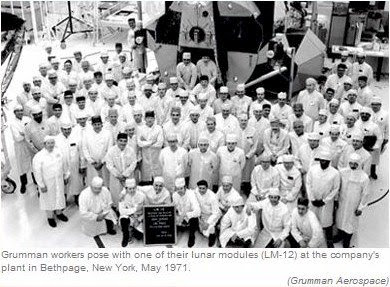 It took 400,000 people, working under extreme pressure, to reach the moon in 1969. Like any army, they suffered casualties. (airspacemag.com)
It took 400,000 people, working under extreme pressure, to reach the moon in 1969. Like any army, they suffered casualties. (airspacemag.com)Mollohan's cuts passed by the House
His predecessor, Franklin Roosevelt said of Washington, "never make the mistake of thinking anything here happens by accident.
Which make poignant the fact while NASA at large was distracted by the logistical and mechanical concerns of launching Endeavour, and STS-127, not long after Trans Lunar Injection for LRO & LCROSS, even as the agency was celebrating "America's return to the Moon", the U.S. House voted 259-157 to cut $700 million from its budget, over the objections of President Obama.
That plan now heads to the Senate. All U.S. spending plans must begin in the House, where the U.S. Constitution seats "the power of the purse." The House has this singular privilege because, Thomas Jefferson wrote, it is the body closest to the People, its entire membership must be elected every two years.
Mark Matthews of the Orlando Sentinel's The Write Stuff, wrote, "NASA still would receive about $18.2 billion under the proposal, but the lawmaker who oversees NASA spending wanted to cut about $670 million from an earlier request by the White House for the agency's exploration budget until a new independent panel -- asked for by the Obama administration -- concludes its review of NASA’s post-shuttle plans.
“It is a pause, a time-out, to allow the president to establish his vision for human space exploration and to commit to realistic future funding levels to realize this vision,” according to an earlier memo written by U.S. Rep. Alan Mollohan, the West Virginia Democrat who chairs the appropriations subcommittee of Commerce, Justice and Science.
The White House opposed the House action in a memo earlier this week. (pdf)
“The Administration is concerned with the reduction of $670 million from the President's FY 2010 request for Exploration Systems. This large reduction would likely cause major negative impacts to any options that may emerge from the ongoing blue ribbon review of U.S. human space flight plans,” according to a memo released by the Office of Management and Budget, which reports to the president.
The NASA cuts were included as part of a much broader bill that outlined about $64 billion in congressional spending on the Department of Justice, NASA, NOAA and several other government agencies, according to budget documents released before the floor debate.
Among those who opposed the bill was U.S. Rep. Suzanne Kosmas, a Florida Democrat who represents the Kennedy Space Center.
“These cuts will cause years of delays and put at risk the highly skilled workforce that is critical to Central Florida’s economy and that may not be easily reassembled for future programs,” said Kosmas in a statement.
She was one of eight Democrats to oppose the proposal.
And, Matthews rightly points out, "Passage in the House, however, does not guarantee the cuts become law. NASA has several defenders in the Senate, including U.S. Sen. Bill Nelson, (D-Florida), and even Mollohan left open the possibility of restoring funding once the Augustine panel presents its report.
At a Thursday today of the House subcommittee of Space and Aeronautics, U.S. Rep. Pete Olson, (R-Texas), said he had been assured by congressional leaders that the funding would be returned once the Augustine panel was done.
“They promised us that they would work to restore that funding, pending the decision of the Augustine commission,” he said.
The 2010 fiscal year begins October 1, which also marks the beginning of the last year former President Bush and President Obama agree will be the final one for the Space Shuttle system.
Retiring the Shuttle involves more than blocking the Orbiter wheels and setting tie downs, of course. It means the dissolution of a unified team skillset, what has already begun, and even environmental impact statements.
Meanwhile, writing in a guest column for Florida Today, Robert Hopkins, former chief of strategic communications at NASA, called H.R. 2847 a "shortsighted, reckless plan."
"Congressional appropriators are moving to dial back funding for our nation’s space program. Specifically, legislators have called for a “time out” in exploration, cutting funding by $670 million for fiscal year 2010.
"With the shuttle due to retire by 2010, for the first time in over 28 years, the U.S. will have no capability to transport humans into space. We will be reliant on the Russians to ferry our astronauts and cargo to the International Space Station until a replacement is completed.
"There are significant economic and international implications."
Friday, June 19, 2009
Last HDTV from Kaguya
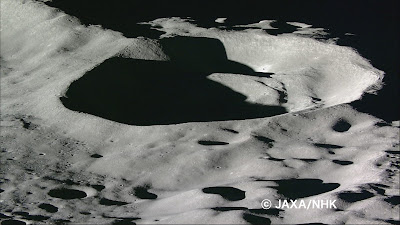 |
| From Kaguya HDTV |
Note: The above is nearly the last from Kaguya. We will be uploading some favorites to the linked album in coming days - Joel Raupe
The images are attached below. The KAGUYA was launched on September 14, 2007, and was controlled to be dropped to the Moon on June 11, 2009, as its mission was completed.
The series of continued shots was taken with an interval of about one minute by the HDTV while the KAGUYA was maneuvered to decrease its altitude toward the impact position (around GILL crater.)
We can see the approaching Moon surface as the KAGUYA went closer to it. After the final image, the KAGUYA moved into the shaded area to make its final landing, thus it was pitch dark while taking an image.
This is the very final image shooting of the Moon by the KAGUYA HDTV.
You can enjoy images taken by the KAGUYA HDTV through JAXA Digital Archives, the KAGUYA Image Gallery, and the JAXA channel on YouTube.
Our sincere thanks to Junya Terazono for endeavoring to continue to keep Lunatics throughout the world of the latest images and releases all during the recently ended Kaguya mission.
NHK Kaguya Archives & a Link to this Press Release.
http://www.jaxa.jp/press/2009/06/20090619_kaguya_hdtv_e.html#at
Leibnitz β - Ghost Mountain
That remainder, as you can see above, is significant, however. An obvious massif, it appears clearly in these improved Goldstone radar maps, released June 18, and on the latest lidar maps produced by JAXA from Kagyua data, released last month. The lidar data from the U.S. NASA/DOD platform Clementine in 1994 probably deserves some credit, and many others, also, for having revealed its incredible true nature.
Color photography did not improve things much. It took a lot of laser data points, and rare radar opportunities from Earth, to bring out the Lβ massif from its background.
The eventual impacts of the LCROSS Centaur upper stage (and its shepherding satellite) are likely to happen somewhere in the area seen above, though some better candidates for abyssal, permanently darkened crater targets are largely blocked from our view from Earth by Lβ and its companion, the comma-shaped "Malapert" mountain.
Malapert carries a name really owned by a crater group, centered "behind" it, where a single large crater was once thought to be. Kaguya's HDTV "earthset" features our world, falling out of view behind the peak, which was once also a candidate for a "peak of perpetual sunshine."
Indeed, the Sun almost always does shine somewhere along the spine of that mountain, though not always in the same spot. The name has probably stuck.
Lβ and Malapert mountain are actually part of a much larger feature. They are the Near Side parts of the outer wall of the oldest undisputed basin on the Moon, undiscovered until the Soviet Union took the first pictures of the Far Side in 1959.
From Malapert South Pole-Aitken Basin stretches past the Moon's South Pole (just out of view, near the rim of Shackleton to the right) and then north on the Far Side nearly to the equator. SPA Basin includs the lowest elevations on the Moon, twenty kilometers lower than the highest point on Lβ.

